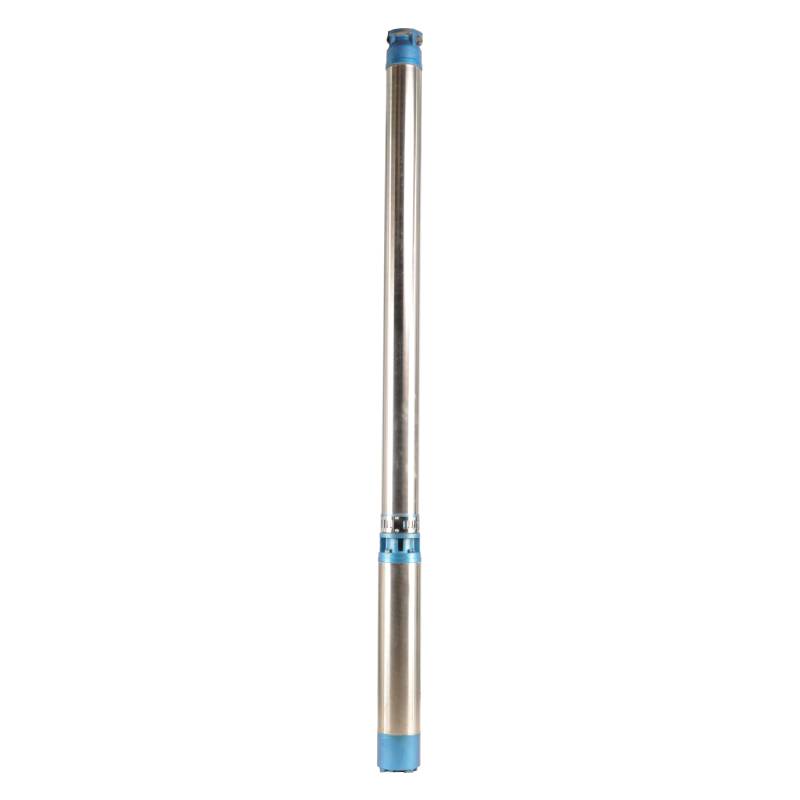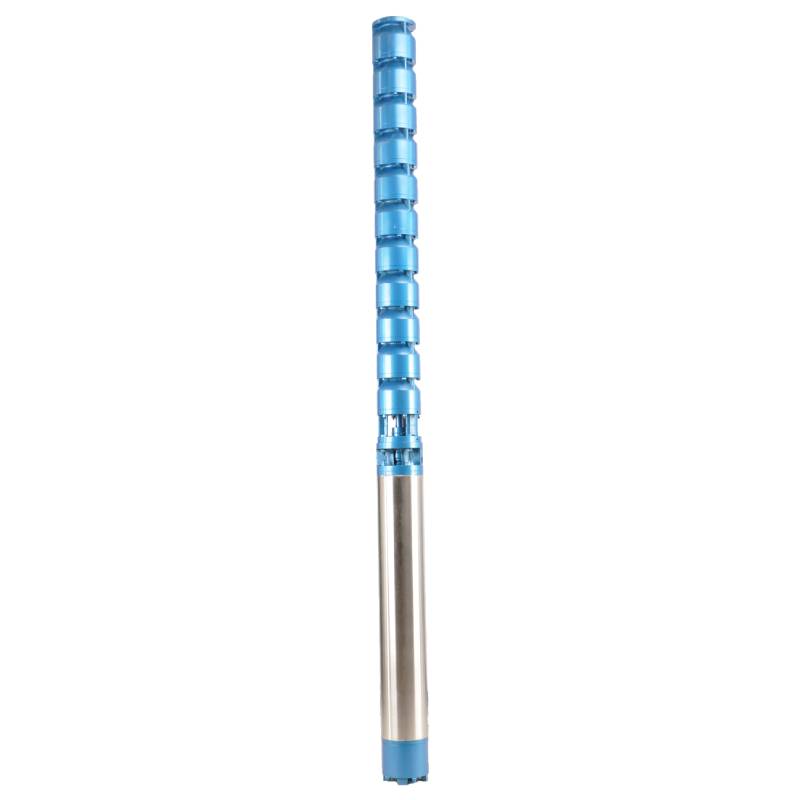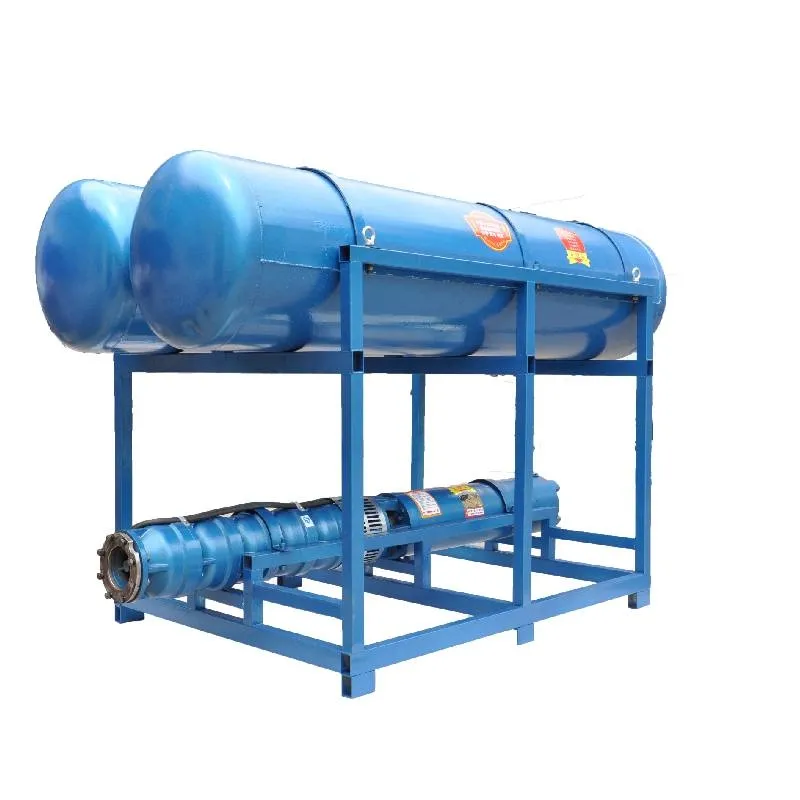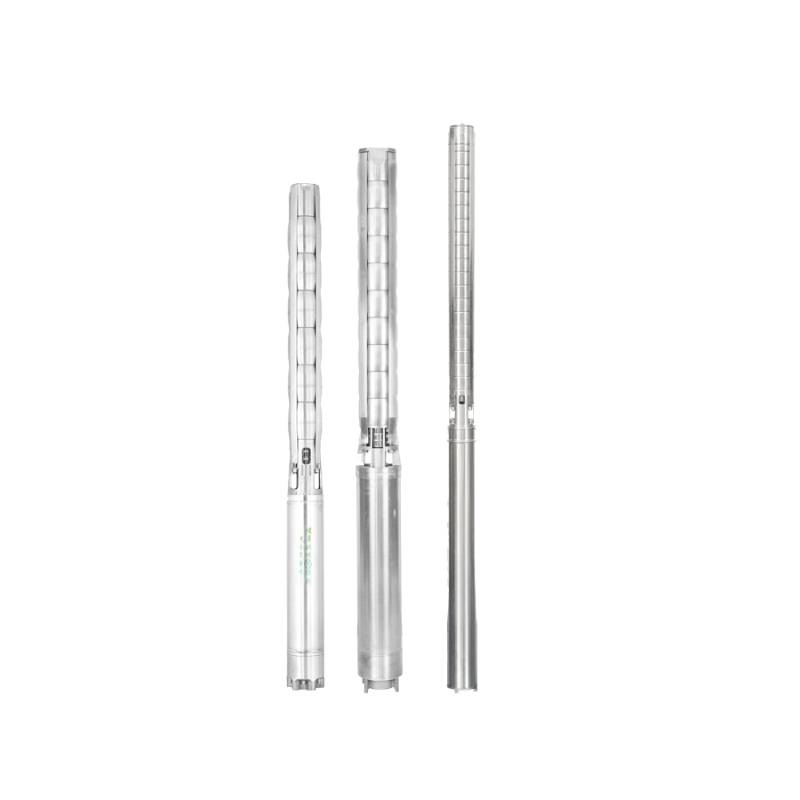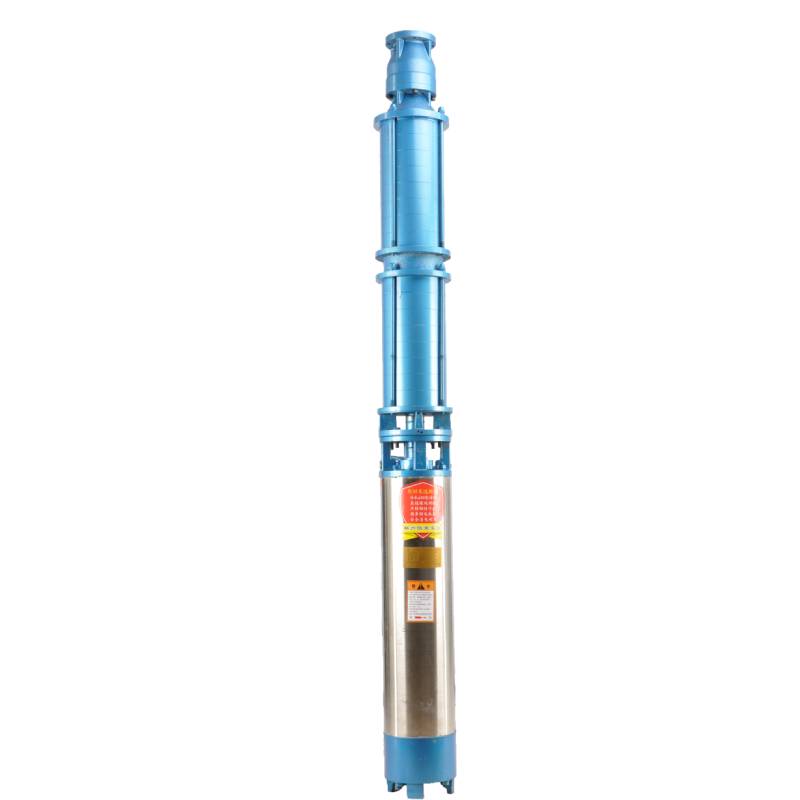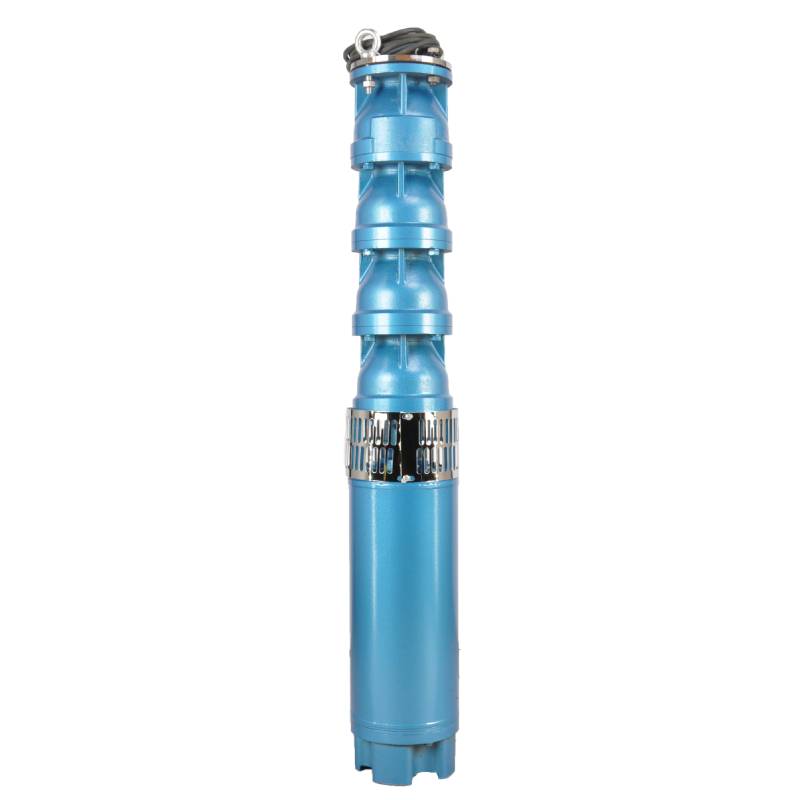The variable frequency winding design ensures the motor's long-term smooth conversion operation between 1HZ-50HZ, energy saving and longer service life. This product stands out for its advanced technology and efficient performance, which can achieve energy-saving and environmentally friendly operation, while ensuring the stability and reliability of the motor for long-term use. Not only that, its design makes the product with a longer life, bringing more value to users. Whether in home applications or industrial fields, this motor can provide you with excellent performance to meet a variety of needs.
1,Power supply: three-phase AC 380V (tolerance + / - 5%), 50HZ (tolerance + / - 1%).
2, calidad del agua:
(1) water temperature is not higher than 20 °C;
(2) el contenido de impurezas sólidas (relación de masa) no es superior al 0,01%;
(3) valor de PH (pH) 6,5-8,5;
(4) el contenido de sulfuro de hidrógeno no es superior a 1,5 mg/l;
(5) el contenido de iones cloruro no supera los 400 mg/l.
3, the motor is a closed or water-filled wet structure, before use the submersible motor cavity must be full of clean water, to prevent false full, and then tighten the water injection, air release bolts, otherwise not allowed to use
4, the submersible pump must be completely submerged in the water, the diving depth is not greater than 70m, the bottom of the submersible pump from the bottom of the well is not less than 3m.
5, el flujo de agua del pozo debe poder cumplir con la salida de agua de la bomba sumergible y el funcionamiento continuo, la salida de agua de la bomba sumergible debe controlarse entre 0,7 y 1,2 veces el flujo nominal.
6, el pozo debe ser recto, la bomba sumergible no se puede usar ni descargar, solo uso vertical.
7, la bomba sumergible debe combinarse con el cable de acuerdo con los requisitos y el dispositivo externo de protección contra sobrecarga.
8, the pump is strictly prohibited without water no-load test machine.
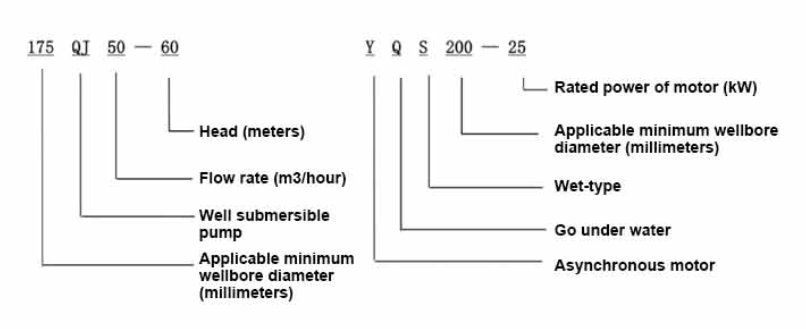
| Modelo | Caudal (m3/h) | Cabeza (metro) |
Velocidad de rotación (punto de cambio) |
Bomba de agua(%) | Salida diámetro (mm) |
Aplicable bien diámetro (mm) |
Clasificado potencia (kilovatios) |
Clasificado voltaje(V) |
Clasificado corriente(A) |
Eficiencia motora (%) | power factorcosφ | Unidad Tamaño máximo radial (mm) |
Observación | |||||||||
| 135QJ5-34 | 5 | 34 | 2850 | 40 | 135arriba | 1.5 | 380 | 4.23 | 128 | |||||||||||||
| 135QJ5-51 | 51 | 2.2 | 6.03 | |||||||||||||||||||
| 135QJ5-68 | 68 | 3 | 8.01 | |||||||||||||||||||
| 135QJ5-85 | 85 | 4 | 10.53 | |||||||||||||||||||
| 135QJ5-102 | 102 | 5.5 | 14.1 | |||||||||||||||||||
| 135QJ5-119 | 119 | 5.5 | 14.1 | |||||||||||||||||||
| 135QJ5-240 | 240 | 11 | 26.28 | |||||||||||||||||||
| 135QJ5-280 | 5 | 280 | 2850 | 40 | 135arriba | 13 | 380 | 30.87 | 128 | |||||||||||||
| 135QJ5-320 | 320 | 15 | 35.62 | |||||||||||||||||||
| 135QJ10-24 | 10 | 24 | 2850 | 50 | 135arriba | 1.5 | 380 | 4.23 | 128 | |||||||||||||
| 135QJ10-32 | 32 | 2.2 | 6.03 | |||||||||||||||||||
| 135QJ10-48 | 48 | 3 | 8.01 | |||||||||||||||||||
| 135QJ10-56 | 56 | 4 | 10.53 | |||||||||||||||||||
| 135QJ10-72 | 72 | 5.5 | 14.1 | |||||||||||||||||||
| 135QJ10-80 | 80 | 5.5 | 14.1 | |||||||||||||||||||
| 135QJ10-104 | 104 | 7.5 | 19.0 | |||||||||||||||||||
| 135QJ10-120 | 120 | 7.5 | 19.0 | |||||||||||||||||||
| 135QJ10-136 | 136 | 9.2 | 22.7 | |||||||||||||||||||
| 135QJ10-180 | 180 | 11 | 26.28 | |||||||||||||||||||
| 135QJ10-210 | 210 | 13 | 30.87 | |||||||||||||||||||
| 135QJ10-240 | 240 | 15 | 35.62 | |||||||||||||||||||
| 135QJ10-300 | 300 | 18.5 | 43.12 | |||||||||||||||||||
| 135QJ15-36 | 15 | 36 | 2850 | 50 | 135arriba | 2.2 | 380 | 6.03 | 128 | |||||||||||||
| 135QJ15-39 | 39 | 3 | 8.01 | |||||||||||||||||||
| 135QJ15-46 | 46 | 4 | 10.53 | |||||||||||||||||||
| 135QJ15-52 | 52 | 4 | 10.53 | |||||||||||||||||||
| 135QJ15-59 | 59 | 5.5 | 14.1 | |||||||||||||||||||
| 135QJ15-65 | 65 | 5.5 | 14.1 | |||||||||||||||||||
| 135QJ15-78 | 78 | 7.5 | 19.0 | |||||||||||||||||||
| 135QJ15-91 | 91 | 7.5 | 19.0 | |||||||||||||||||||
| 135QJ15-104 | 104 | 9.2 | 22.7 | |||||||||||||||||||
| 135QJ15-120 | 120 | 11 | 26.28 | |||||||||||||||||||
| 135QJ15-142 | 142 | 13 | 30.87 | |||||||||||||||||||
| 135QJ15-162 | 162 | 15 | 35.62 | |||||||||||||||||||
| 135QJ15-200 | 200 | 18.5 | 43.12 | |||||||||||||||||||
| 135QJ20-16 | 20 | 16 | 2850 | 50 | 135above | 2.2 | 380 | 6.03 | 128 | |||||||||||||
| 135QJ20-24 | 24 | 3 | 8.01 | |||||||||||||||||||
| 135QJ20-32 | 32 | 4 | 10.53 | |||||||||||||||||||
| 135QJ20-40 | 40 | 4 | 10.53 | |||||||||||||||||||
| 135QJ20-48 | 48 | 5.5 | 14.1 | |||||||||||||||||||
| 135QJ20-56 | 56 | 5.5 | 14.1 | |||||||||||||||||||
| 135QJ20-64 | 64 | 7.5 | 19.0 | |||||||||||||||||||
| 135QJ20-72 | 72 | 7.5 | 19.0 | |||||||||||||||||||
| 135QJ20-80135QJ20-100 | 80 | 9.2 | 22.7 | |||||||||||||||||||
| 100 | 11 | 26.28 | ||||||||||||||||||||
| 135QJ20-120 | 120 | 13 | 30.87 | |||||||||||||||||||
| 135QJ20-136 | 136 | 15 | 35.62 | |||||||||||||||||||
| 135QJ20-168135QJ25-12 | 168 | 18.5 | 43.12 | |||||||||||||||||||
| 25 | 12 | 2850 | 65 | 135arriba | 2.2 | 380 | 6.03 | 128 | ||||||||||||||
| 135QJ25-18 | 18 | 3 | 8.01 | |||||||||||||||||||
| 135QJ25-24 | 24 | 4 | 10.53 | |||||||||||||||||||
| 135QJ25-30 | 30 | 4 | 10.53 | |||||||||||||||||||
| 135QJ25-36 | 36 | 5.5 | 14.1 | |||||||||||||||||||
| 135QJ25-48 | 48 | 7.5 | 19.0 | |||||||||||||||||||
| 135QJ25-60 | 60 | 9.2 | 22.7 | |||||||||||||||||||
| 135QJ25-82 | 82 | 11 | 26.28 | |||||||||||||||||||
| 135QJ25-97 | 97 | 13 | 30.87 | |||||||||||||||||||
| 135QJ25-110 | 110 | 15 | 35.62 | |||||||||||||||||||
| 135QJ25-130 | 130 | 18.5 | 43.12 | |||||||||||||||||||
| 135QJ32-24 | 32 | 24 | 2850 | 80 | 135arriba | 4 | 380 | 10.53 | 128 | |||||||||||||
| 135QJ32-30 | 30 | 5.5 | 14.1 | |||||||||||||||||||
| 135QJ32-42 | 42 | 7.5 | 19.0 | |||||||||||||||||||
| 135QJ32-54 | 54 | 9.2 | 22.7 | |||||||||||||||||||
| 135QJ32-68 | 68 | 11 | 26.28 | |||||||||||||||||||
| 135QJ32-80 | 80 | 13 | 30.87 | |||||||||||||||||||
| 135QJ32-92 | 92 | 15 | 35.62 | |||||||||||||||||||
| 135QJ32-104 | 104 | 18.5 | 43.12 | |||||||||||||||||||
| 135QJ40-46 | 40 | 46 | 2850 | 80 | 135arriba | 11 | 380 | 26.28 | 128 | |||||||||||||
| 135QJ40-54 | 54 | 13 | 30.87 | |||||||||||||||||||
| 135QJ40-62 | 62 | 15 | 35.62 | |||||||||||||||||||
| 135QJ40-84 | 84 | 18.5 | 43.12 | |||||||||||||||||||
1, well submersible pump for clean water pump, prohibit the new well, pumping sediment and muddy water,
2, well water pump voltage grade of 380/50HZ, the use of other voltage grades of submersible motors need to be customized. The underground cable must use waterproof cable, must be equipped with starting equipment, such as distribution box, start not ready should have commonly used motor comprehensive protection function, such as short circuit overload protection, phase protection, undervoltage protection, grounding protection, idling protection, in case of abnormal conditions, the protection device should be timely action trip.
3, the installation and use of the pump must be reliably grounded, prohibit the push and pull switch when the hands and feet are wet, the installation and maintenance of the pump must be cut off the power supply, the use of the pump place to set up "to prevent electric shock" obvious signs:
4, down the well or before installation, the motor cavity must be filled with distilled water or non-corrosive clean cold boiling water, tighten the / water bolt, the pump on the ground test run, must be to the pump chamber water lubrication rubber bearings, instant start not more than a second, see whether the steering is the same as the steering instructions. When the pump is upright, pay attention to safety, prevent overturning injury.
5, estrictamente de acuerdo con las disposiciones de la elevación de la bomba, rango de uso del flujo, para evitar un flujo bajo o una fuerza de bombeo de elevación alta, el cojinete de empuje y otras partes del desgaste, la sobrecarga del motor se quemó 6, después de que la bomba baja el pozo, la medición de la resistencia del aislamiento del motor a tierra no debe ser inferior a 100 M, después del inicio para observar el voltaje y la corriente, verifique el aislamiento del devanado del motor, si cumple con los requisitos; La temperatura del lugar de almacenamiento de la bomba, si es inferior al punto de congelación, debe secar el agua de la cavidad del motor para evitar daños por hielo en el agua de la cavidad del motor causados por la baja temperatura.
The pump parts are mainly composed of pump shaft, impeller, shunt shell, rubber bearing, check valve body (optional) and other components. The motor parts are mainly composed of base, pressure regulating diaphragm, thrust bearing, thrust plate, lower guide bearing seat, stator, rotor, upper guide bearing seat, sand discharging ring, water inlet section, and lead cable.
Las principales características del producto incluyen:
The main characteristic of the product is that the pump is a water-immersed three-phase asynchronous motor, and the motor cavity is full of water for cooling the motor and lubricating the bearing. The pressure regulating diaphragm at the bottom of the motor is used to adjust the expansion-contraction pressure difference of the water inside the body caused by the change of temperature. At the same time, in order to prevent the sand particles in the well water from entering the motor, two oil seals are installed at the end of the motor shaft, and the sand discharging ring is installed to form a sand control structure. In order to prevent the pump shaft from beating when starting up, the pump shaft and the motor shaft are connected by a coupling, and the thrust bearing is installed at the bottom of the motor. In addition, the motor and the pump bearing are water-lubricated, and the stator winding of the motor uses high-quality submersible motor winding to ensure high insulation performance. The overall design is made of computer CAD, with simple structure and superior technical performance.

(1)Preparación antes de la instalación:
1. Verifique si la bomba sumergible cumple con las condiciones de uso y el alcance especificado en el manual.
2. Utilizando un objeto pesado con un diámetro igual al diámetro exterior máximo de la bomba sumergible, mida si el diámetro interior del pozo puede adaptarse a la bomba sumergible y mida si la profundidad del pozo cumple con los requisitos de instalación.
3. Verifique si el pozo está limpio y si el agua del pozo está turbia. Nunca utilice una bomba eléctrica sumergible para lavar el agua de lodo y arena de la bomba welor para evitar daños prematuros a la bomba eléctrica sumergible.
4. Compruebe si la posición de la abrazadera de instalación del cabezal de pozo es adecuada y si puede soportar la calidad de toda la unidad.
5. Verifique si los componentes de la bomba sumergible están completos e instalados correctamente de acuerdo con el diagrama de ensamblaje en el manual. Retire la pantalla del filtro y gire el acoplamiento para ver si gira con flexibilidad.
6. Desenrosque el tornillo de agua y llene la cavidad del motor con agua limpia y no corrosiva (nota: asegúrese de llenarla), luego apriete el tornillo de agua. Después de 12 horas de inyección de agua, la resistencia de aislamiento del motor no debe ser inferior a 150 M Q cuando se mide con una mesa vibratoria de 500 V.
7. Cable joint, cut off a 120mm rubber sleeve from one end of the outgoing cable and the matching cable with an electrician's knifethen stagger the length of the three core wires in a stepped shape, peel off a 20mm copper core, scrape of the oxide layer on theoutside of the copper wire with a knife or sand cloth, and insert the two connected wire ends in palirs.After tying the layer tightly with fine copper wire, solder it thoroughly and firmly, and sand of any. burrs on the surface. Then, forthe three joints, use polyvester insulation tape to wrap them in a semi stacked manner for three lavers. Wrap the two ends of thewrapping layer tightywith nyion thread,and then use a semi stacked method to wrap the tape for three layers. Wrap the outellayer with high-pressure insulation tape for three layers. Finally, fold the threestrands together and repeatedly wrap them for fivelayers with high-pressure tape. Each layer must be tightly tied, and the interlayer joints must be tight and fimm to prevent water frompenetrating and damaging the insulation, After wrapping, soak in water at room temperature of 20 ’c for 12 hours, and measurethe insulation resistance with a shaking table, which should not be less than 100M Ω
El diagrama del proceso de cableado del cable adjunto es el siguiente:
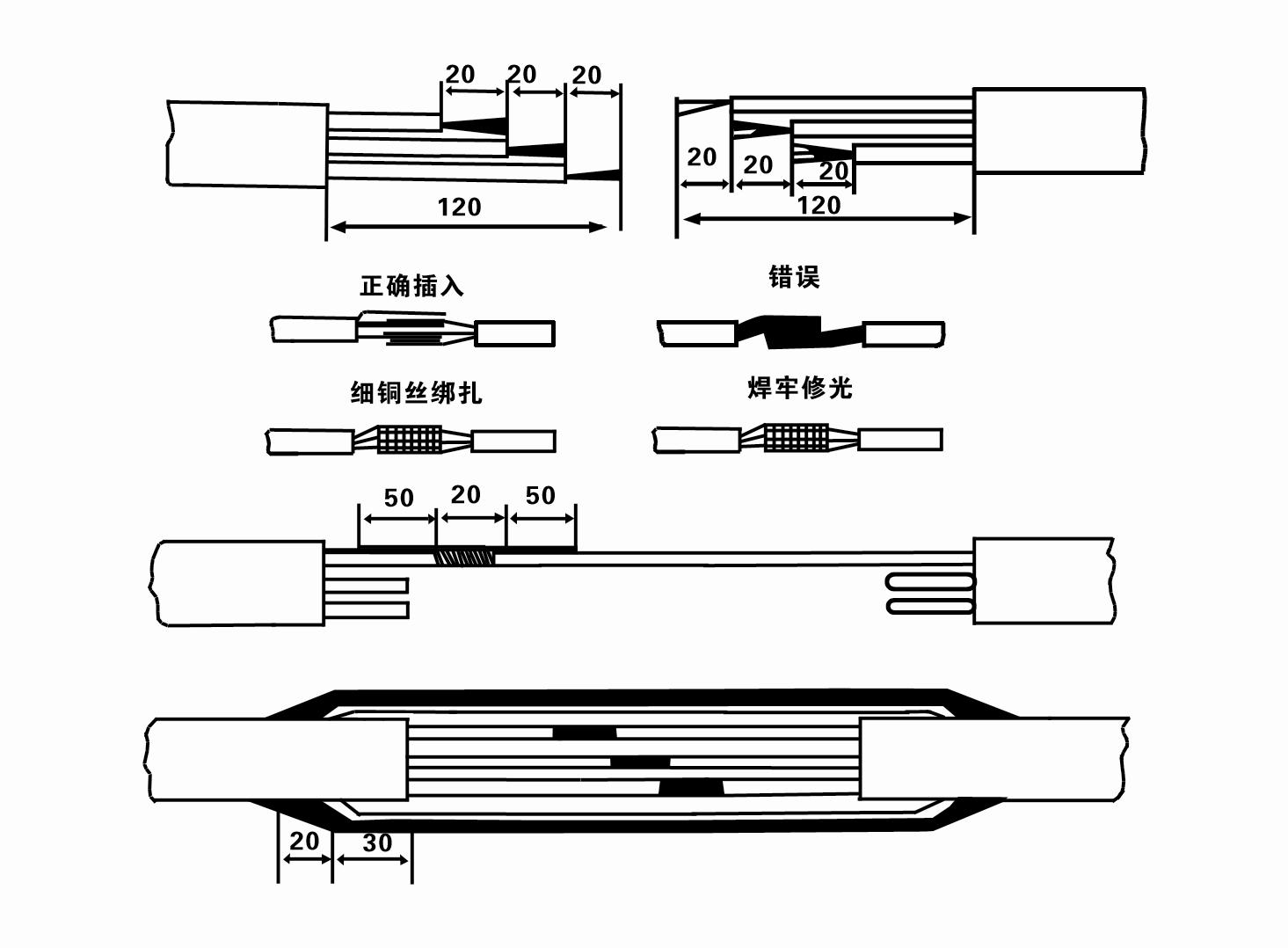
8. Utilice un multímetro para comprobar si los cables trifásicos están conectados y si la resistencia de CC está aproximadamente equilibrada.
9. Verifique si el circuito y la capacidad del transformador están sobrecargados y luego conecte el interruptor de protección contra sobrecarga o el equipo de arranque. Consulte la Tabla 2 para conocer modelos específicos y luego vierta un balde de agua en la bomba de agua desde la salida de la bomba de agua para lubricar los cojinetes de goma de la bomba y luego coloque la bomba eléctrica sumergible en posición vertical y estable. Inicio (no más de un segundo) y compruebe si la dirección de dirección es consistente con la señal de dirección. De lo contrario, cambie los dos conectores del cable trifásico. Luego instale el filtro y prepárese para bajar al pozo. Si se utiliza en ocasiones especiales (como zanjas, acequias, ríos, estanques, estanques, etc.), la bomba eléctrica debe estar conectada a tierra de manera confiable.
(2) Equipos y herramientas de instalación:
1. Un par de cadenas de elevación para más de dos toneladas.
2. Un trípode con una altura vertical no inferior a cuatro metros.
3. Dos cuerdas para colgar (cables de alambre) que pueden soportar un peso de más de una tonelada (pueden soportar el peso de un juego completo de bombas de agua).
4. Instale dos pares de abrazaderas (férulas).
5. Llaves, martillos, destornilladores, herramientas e instrumentos eléctricos, etc.
(3)Instalación de bomba eléctrica:
1. El diagrama de instalación de la bomba eléctrica sumergible se muestra en la Figura 2. Las dimensiones de instalación específicas se muestran en la Tabla 3 "Lista de dimensiones de instalación de la bomba eléctrica sumergible".
2. Las bombas eléctricas sumergibles con una altura inferior a 30 metros se pueden izar directamente al pozo utilizando mangueras y cables metálicos u otros cables de cáñamo que puedan soportar todo el peso de toda la máquina, las tuberías de agua y el agua en las tuberías.
3. Las bombas con una altura de más de 30 metros utilizan tuberías de acero y la secuencia de instalación es la siguiente:
①Utilice una abrazadera para sujetar el extremo superior de la parte de la bomba de agua (el motor y la bomba de agua se han conectado en este momento), levántelo con una cadena colgante y átelo lentamente al pozo hasta que coloque la abrazadera en la boca del pozo y retire la cadena colgante.
② Utilice otro par de abrazaderas para sujetar un tubo, levántelo con una cadena colgante a 15 cm de la brida y bájelo lentamente. Entre la brida de la tubería y la brida de la bomba Coloque la almohadilla de goma en su lugar y apriete la tubería y la bomba de manera uniforme con pernos, tuercas y arandelas de resorte.
③ Levante ligeramente la bomba sumergible, retire la abrazadera en el extremo superior de la bomba de agua, ate el cable firmemente a la tubería de agua con una cinta plástica y átelo lentamente hasta que la abrazadera quede colocada en la boca del pozo.
④Utilice el mismo método para conectar todas las tuberías de agua al pozo.
⑤Después de conectar el cable de salida al interruptor de control, se conecta a la fuente de alimentación trifásica.
(4) Cosas a tener en cuenta durante la instalación:
1. Si se encuentra un fenómeno de atasco durante el proceso de bombeo, gire o tire de la tubería de agua para superar el punto de atasco. Si varias medidas aún no funcionan, no fuerce la bomba hacia abajo para evitar daños a la bomba eléctrica sumergible y al pozo.
2. Durante la instalación, se debe colocar una almohadilla de goma en la brida de cada tubería y apretarla uniformemente.
3. Cuando la bomba de agua se baja al pozo, debe colocarse en el medio de la tubería del pozo para evitar que la bomba funcione contra la pared del pozo durante mucho tiempo, lo que hace que la bomba vibre y el motor barre y quema. .
4. Determine la profundidad de la bomba de agua hasta el fondo del pozo de acuerdo con las condiciones del flujo de arena y limo del pozo. No entierre la bomba en el barro. La distancia desde la bomba de agua hasta el fondo del pozo generalmente no es inferior a 3 metros (ver Figura 2).
5. La profundidad de entrada de agua de la bomba de agua no debe ser inferior a 1-1,5 metros desde el nivel dinámico del agua hasta el nodo de entrada de agua (consulte la Figura 2). De lo contrario, los cojinetes de la bomba de agua podrían dañarse fácilmente.
6. La elevación de la bomba de agua no puede ser demasiado baja. De lo contrario, se debe instalar una válvula de compuerta en la tubería de agua de la boca del pozo para controlar el flujo de la bomba en el punto de flujo nominal y evitar que el motor se sobrecargue y se queme debido a grandes caudales.
7. Cuando la bomba de agua está funcionando, la salida de agua debe ser continua y uniforme, la corriente debe ser estable (en condiciones de trabajo nominales, generalmente no más del 10% de la corriente nominal) y no debe haber vibraciones ni ruidos. Si hay alguna anomalía, se debe detener la máquina para descubrir la causa y eliminarla.
8. Al realizar la instalación, preste atención a la configuración del cable de tierra del motor (consulte la Figura 2). Cuando la tubería de agua sea de acero, condúzcala desde la abrazadera del cabezal del pozo; Cuando la tubería de agua sea de plástico, condúzcala desde la marca de conexión a tierra de la bomba eléctrica.
- 1.After the submersible pump is installed, check the insulation resistance and three-phase conduction from the switch again, check whether the instrument and the connection of the start equipment are wrong, if there is no problem, the trial machine can be started, and after the start, observe whether the indicator readings of the instrument exceed the rated voltage and current specified on the nameplate, observe whether the pump has noise and vibration phenomenon, and put into operation if everything is normal.
- 2. After the first operation of the pump for four hours, the motor should be stopped to test the thermal insulation resistance quickly, and its value should not be less than 0.5 megaohm.
- 3. After the pump is stopped, it should be started after five minutes to prevent the water column in the pipe from being completely reflowed and causing the motor to burn out due to excessive current.
- 4. Our pump is designed to provide efficient, reliable and lasting pumping solutions.After normal operation, in order to prolong the service life of the pump, it is necessary to check the power supply voltage, running current and insulation resistance regularly to ensure that they are normal.
- If the following conditions are found, the machine should be shut down immediately to eliminate the fault:
- - the current exceeds 20% under the rated working conditions;
- - the dynamic water level drops to the inlet section, resulting in intermittent drainage;
- - the submersible pump vibrates violently or emits noisy sounds;
- - the power supply voltage is lower than 340 volts;
- - one phase of a fuse is blown out;
- - the water pipe is damaged;
- - the thermal insulation resistance of the motor to the ground is less than 0.5 megaohm.
- The steps of disassembling the unit include unlocking the cable holder, taking off the pipe part, removing the line protection plate, rotating the drain screw and emptying all the water in the motor chamber, taking out the filter and loosening the screw of the coupling fixed to the motor shaft.Unscrew the bolt connecting the water inlet section and the motor, and separate the pump and the motor (note that the unit should be placed horizontally when separating to prevent the bending of the pump shaft).
- 5. The disassembly sequence of the pump includes: water inlet part, impeller, shunt shell, impeller, check valve body.When removing the impeller, use a special tool to loosen the cone sleeve fixing the impeller.During the disassembly process, avoid bending the pump shaft and damaging various parts.The disassembly process of the motor includes: placing the motor on the platform, and then removing the nuts on the studs, base, shaft head lock nut, thrust plate, key, lower guide rail, bearing seat and bolt from the bottom of the motor, then removing the rotor (be careful not to damage the winding), and finally removing the connecting parts and upper guide bearing seat. Before assembling the unit, it is necessary to clean the rust and dirt of each part, and apply sealant on each mating surface and fastener, and then assemble it in the opposite order of disassembly.After assembly, the coupling should be flexibly rotated, and then the filter should be put on to test the machine. Our pump products are designed to provide superior performance and reliability to meet your pumping needs.
- 6. Submersible pumps operating every year, or less than a year of operation but the submersible time has reached two years, should be taken out of the well according to the 5th dismantled maintenance, replacement of worn parts.
1, saque el agua de la cavidad del motor (especialmente en invierno para evitar que el motor se congele) y ate bien el cable.
2, store in an indoor room without corrosive substances and gases, with a temperature below 40 °C.
3. El uso prolongado debe prestar atención a la prevención de la oxidación de las bombas sumergibles.
- Impulso
- Camisa del eje
- Manguito de eje de goma
- anillo de sellado
01 Toma de agua de pozo profundo
02 Suministro de agua en altura
03 suministro de agua de montaña
04 torre de agua
05 Riego agrícola
06 riego de jardines
07 toma de agua del río
08 agua sanitaria

